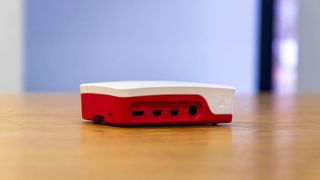Raspberry Pi doubled its display outputs to grow its enterprise business
Extra port was added at request of Citrix to enable thin-client usage

The newly-released Raspberry Pi 400, along with its predecessor the Raspberry Pi 4, are the first devices in the range to support dual display outputs, but the feature wouldn’t exist if it wasn’t for Citrix.
Raspberry Pi has had an ongoing relationship with the enterprise software vendor for a number of years, with the company using Pis as thin-client devices to access its desktop virtualisation products. However, according to Raspberry Pi founder Eben Upton, Citrix requested the company add an additional display port in order to enable more sales.
“The dual display output is very important, actually,” Upton told the IT Pro Podcast. “One thing we discovered from our engagements with corporate thin client customers with Raspberry Pi 3 is that you can only access a very small fraction of the market if you only have one display output.”
“It’s actually why the Raspberry Pi 4 has two display outputs,” he said; “because Citrix told us that their integrator partners were struggling to sell Raspberry Pi 3 into thin client accounts, because it didn’t support two displays. So now we do.”
The Pi 400 is a unique product in the company’s range, consisting of a Raspberry Pi 4 housed within the body of the official Raspberry Pi keyboard. Along with making it an all-in-one plug-and-play device, the design also allows for greater thermal efficiency, which means higher clock speeds and better performance. It’s also a self-contained unit, with the $100 kit coming with a mouse, preloaded microSD card and all the cabling needed to connect to a monitor and get up and running right away.
Raspberry Pi has some presence in the enterprise market; the company’s stripped down ‘compute module’ has proved popular for prototyping and for enterprise IoT deployments, and its partnership with Citrix has resulted in Raspberry Pis powering around a third of the seats in Denmark’s national healthcare service. It has yet to achieve mainstream success as a business device, but the organisation is hoping to change that with its latest device.
“We have a fantastic relationship with Citrix,” Upton said. “I think increasingly, you find that people who were using Windows Laptops are actually using them to access various sorts of terminal server sessions running somewhere else. There are a lot of commercial users deploying Raspberry Pi 3 or 3+ based thin-clients that are running Windows on a blade server somewhere and then remoting into the desktop. Raspberry Pi 4 continues that, and Raspberry Pi 400 continues it again.”
Get the ITPro. daily newsletter
Receive our latest news, industry updates, featured resources and more. Sign up today to receive our FREE report on AI cyber crime & security - newly updated for 2024.
Adam Shepherd has been a technology journalist since 2015, covering everything from cloud storage and security, to smartphones and servers. Over the course of his career, he’s seen the spread of 5G, the growing ubiquity of wireless devices, and the start of the connected revolution. He’s also been to more trade shows and technology conferences than he cares to count.
Adam is an avid follower of the latest hardware innovations, and he is never happier than when tinkering with complex network configurations, or exploring a new Linux distro. He was also previously a co-host on the ITPro Podcast, where he was often found ranting about his love of strange gadgets, his disdain for Windows Mobile, and everything in between.
You can find Adam tweeting about enterprise technology (or more often bad jokes) @AdamShepherUK.





